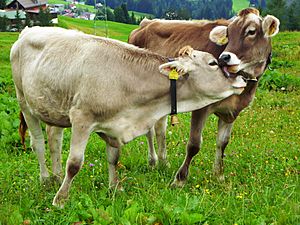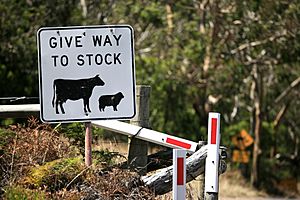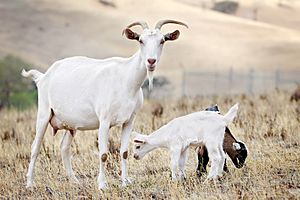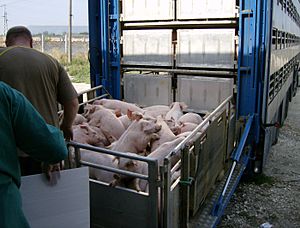Livestock facts for kids
Livestock are domestic animals that are kept by people for food, milk, leather, or wool. Some types of livestock are: cattle, pigs, sheep, goats, and chickens. The group is mostly thought to be cows and bulls. Chickens produce eggs, pigs produce ham, bulls make leather for their pelts, goats and cows create milk, and sheep create wool.
In recent years, some organizations have also raised livestock to promote the survival of rare breeds. The breeding, maintenance, and slaughter of these animals, known as animal husbandry, is a component of modern agriculture that has been practiced in many cultures since humanity's transition to farming from hunter-gatherer lifestyles.
Animal husbandry practices have varied widely across cultures and time periods. Originally, livestock were not confined by fences or enclosures, but these practices have largely shifted to intensive animal farming, sometimes referred to as "factory farming". Now, over 99% of livestock are raised on factory farms. These practices increase yield of the various commercial outputs, but have also led to negative impacts on animal welfare and the environment. Livestock production continues to play a major economic and cultural role in numerous rural communities.
Contents
Etymology
Livestock as a word was first used between 1650 and 1660, as a merger between the words "live" and "stock". In some periods, "cattle" and "livestock" have been used interchangeably. Today, the modern meaning of cattle is domesticated bovines, while livestock has a wider sense.
United States federal legislation defines the term to make specified agricultural commodities eligible or ineligible for a program or activity. For example, the Livestock Mandatory Reporting Act of 1999 (P.L. 106-78, Title IX) defines livestock only as cattle, swine, and sheep, while the 1988 disaster assistance legislation defined the term as "cattle, sheep, goats, swine, poultry (including egg-producing poultry), equine animals used for food or in the production of food, fish used for food, and other animals designated by the Secretary."
Deadstock is defined in contradistinction to livestock as "animals that have died before slaughter, sometimes from illness". It is illegal in many countries, such as Canada, to sell or process meat from dead animals for human consumption.
History
Animal-rearing originated during the cultural transition to settled farming communities from hunter-gatherer lifestyles. Animals are domesticated when their breeding and living conditions are controlled by humans. Over time, the collective behaviour, lifecycle and physiology of livestock have changed radically. Many modern farm animals are unsuited to life in the wild.
The dog was domesticated early; dogs appear in Europe and the Far East from about 15,000 years ago. Goats and sheep were domesticated in multiple events sometime between 11,000 and 5,000 years ago in Southwest Asia. Pigs were domesticated by 8,500 BC in the Near East and 6,000 BC in China. Domestication of the horse dates to around 4000 BC. Cattle have been domesticated since approximately 10,500 years ago. Chickens and other poultry may have been domesticated around 7000 BC.
Types
The term "livestock" is nebulous and may be defined narrowly or broadly. Broadly, livestock refers to any breed or population of animal kept by humans for a useful, commercial purpose. This can mean domestic animals, semidomestic animals, or captive wild animals. Semidomesticated refers to animals which are only lightly domesticated or of disputed status. These populations may also be in the process of domestication.
| Animal / Type | Domestication status | Wild ancestor | Time of first captivity, domestication | Area of first captivity, domestication | Current commercial uses | Picture | Ref |
|---|---|---|---|---|---|---|---|
| Alpaca Mammal, herbivore |
domestic | Vicuña | Between 5000 BC and 4000 BC | Andes | Alpaca fiber, meat |  |
|
| Addax Mammal, herbivore |
domestic | Addax | 2500 BCE | Egypt | Meat, hides |  |
|
| Bali cattle Mammal, herbivore |
domestic | Banteng | Unknown | Southeast Asia, Bali | Meat, milk, draught |  |
|
| Bison Mammal, herbivore |
captive (see also Beefalo) | N/A | Late 19th century | North America | Meat, leather |  |
|
| Camel Mammal, herbivore |
domestic | Wild dromedary and Bactrian camel | Between 4000 BC and 1400 BC | Asia | Mount, pack animal, meat, milk, camel hair |  |
|
| Cattle Mammal, herbivore |
domestic | Aurochs | 6000 BC | Southwest Asia, South Asia, North Africa | Meat (beef, veal), milk, leather, draught | 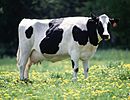 |
|
| Capybara Mammal, herbivore |
captive | Capybara | Unknown | South America | Meat, skins, pet |  |
|
| Collared peccary Mammal, omnivore |
captive | Collared peccary | Unknown | Brazil | Meat, tusks, skins, pet |  |
|
| Deer Mammal, herbivore |
captive | N/A | First century AD | UK | Meat (venison), leather, antlers, antler velvet |  |
|
| Donkey Mammal, herbivore |
domestic | African wild ass | 4000 BC | Egypt | Mount, pack animal, draught, meat, milk |  |
|
| Eland Mammal, herbivore |
domestic | Common eland, Giant eland | Unknown | South Africa, Kenya, Zimbabwe, West Africa | Meat, milk, leather, hides, horns |  |
|
| Elk Mammal, herbivore |
captive | Elk | 1990s | North America | Meat, antlers, leather, hides | 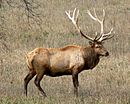 |
|
| Fallow deer Mammal, herbivore |
semidomestic | Fallow deer | 9th century BC | Mediterranean Basin | Meat, antlers, hides, ornamentation |  |
|
| Gayal Mammal, herbivore |
domestic | Gaur | Unknown | Southeast Asia | Meat, draught |  |
|
| Goat Mammal, herbivore |
domestic | Wild goat | 8000 BC | Southwest Asia | Milk, meat, wool, leather, light draught |  |
|
| Guinea pig Mammal, herbivore |
domestic | Cavia tschudii | 5000 BC | South America | Meat, pet |  |
|
| Greater cane rat Mammal, herbivore |
captive | Greater cane rat | Unknown | West Africa | Meat |  |
|
| Greater kudu Mammal, herbivore |
captive | Greater kudu | Unknown | South Africa | Meat, hides, horns, leather, pet |  |
|
| Horse Mammal, herbivore |
domestic | Wild horse | 4000 BC | Eurasian Steppes | Mount, draught, milk, meat, pet, pack animal |  |
|
| Llama Mammal, herbivore |
domestic | Guanaco | 3500 BC | Andes | Pack animal, draught, meat, fiber |  |
|
| Mule Mammal, herbivore |
domestic | Sterile Hybrid offspring of Jack donkey x mare (female horse) | Mount, pack animal, draught |  |
|||
| Moose Mammal, herbivore |
domestic | Moose | 1940s | Russia, Sweden, Finland, Alaska | Meat, milk, antlers, research, draft |  |
|
| Muskox Mammal, herbivore |
domestic | Muskox | 1960s | Alaska | Meat, wool, milk |  |
|
| Pig Mammal, omnivore |
domestic | Wild boar | 7000 BC | Eastern Anatolia | Meat (pork), leather, pet, mount, research |  |
|
| Rabbit Mammal, herbivore |
domestic | Wild rabbit | AD 400-900 | France | Meat, fur, leather, pet, research |  |
|
| Reindeer Mammal, herbivore |
semidomestic | Reindeer | 3000 BC | Northern Russia | Meat, leather, antlers, milk, draught |  |
|
| Sika deer Mammal, herbivore |
domestic | Sika deer | Unknown | Japan, China | Meat, antlers, hides, leather, pet, tourism |  |
|
| Scimitar oryx Mammal, herbivore |
domestic | Scimitar oryx | 2320-2150 BC | Egypt | Meat, sacrifice, horns, hides, leather |  |
|
| Sheep Mammal, herbivore |
domestic | Asiatic mouflon sheep | Between 11000 and 9000 BC | Southwest Asia | Wool, milk, leather, meat (lamb and mutton) |  |
|
| Thorold's deer Mammal, herbivore |
captive | Thorold's deer | Unknown | China | Meat, antlers |  |
|
| White-tailed deer Mammal, herbivore |
captive | White-tailed deer | Unknown | West Virginia, Florida, Colombia | Meat, antlers, hides, pet |  |
|
| Water buffalo Mammal, herbivore |
domestic | Wild Asian water buffalo (Arni) | 4000 BC | South Asia | Mount, draught, meat, milk |  |
|
| Yak Mammal, herbivore |
domestic | Wild yak | 2500 BC | Tibet, Nepal | Meat, milk, fiber, mount, pack animal, draught |  |
|
| Zebu Mammal, herbivore |
domestic | Aurochs | 8000 BC | India | Meat, milk, draught, hides |  |
Farming practices
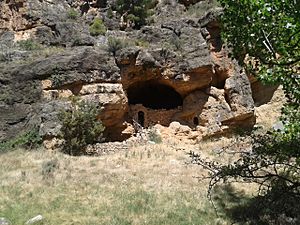
Traditionally, animal husbandry was part of the subsistence farmer's way of life, producing not only the food needed by the family but also the fuel, fertiliser, clothing, transport and draught power. Killing the animal for food was a secondary consideration, and wherever possible its products, such as wool, eggs, milk and blood (by the Maasai) were harvested while the animal was still alive. In the traditional system of transhumance, people and livestock moved seasonally between fixed summer and winter pastures; in montane regions the summer pasture was up in the mountains, the winter pasture in the valleys.
Animals can be kept extensively or intensively. Extensive systems involve animals roaming at will, or under the supervision of a herdsman, often for their protection from predators. Ranching in the Western United States involves large herds of cattle grazing widely over public and private lands.Similar cattle stations are found in South America, Australia and other places with large areas of land and low rainfall. Ranching systems have been used for sheep, deer, ostrich, emu, llama and alpaca. In the uplands of the United Kingdom, sheep are turned out on the fells in spring and graze the abundant mountain grasses untended, being brought to lower altitudes late in the year, with supplementary feeding being provided in winter. In rural locations, pigs and poultry can obtain much of their nutrition from scavenging, and in African communities, hens may live for months without being fed, and still produce one or two eggs a week. At the other extreme, in the more developed parts of the world, animals are often intensively managed; dairy cows may be kept in zero-grazing conditions with all their forage brought to them; beef cattle may be kept in high density feedlots; pigs may be housed in climate-controlled buildings and never go outdoors; poultry may be reared in barns and kept in cages as laying birds under lighting-controlled conditions. In between these two extremes are semi-intensive, often family run farms where livestock graze outside for much of the year, silage or hay is made to cover the times of year when the grass stops growing, and fertiliser, feed and other inputs are bought onto the farm from outside.
Predation
Livestock farmers have suffered from wild animal predation and theft by rustlers. In North America, animals such as the gray wolf, grizzly bear, cougar, and coyote are sometimes considered a threat to livestock. In Eurasia and Africa, predators include the wolf, leopard, tiger, lion, dhole, Asiatic black bear, crocodile, spotted hyena, and other carnivores. In South America, feral dogs, jaguar, anacondas, and spectacled bears are threats to livestock. In Australia, the dingo, fox, and wedge-tailed eagle are common predators, with an additional threat from domestic dogs that may kill in response to a hunting instinct, leaving the carcass uneaten.
Transportation and marketing
Since many livestock are herd animals, they were historically driven to market "on the hoof" to a town or other central location. The method is still used in some parts of the world.
Truck transport is now common in developed countries.
Local and regional livestock auctions and commodity markets facilitate trade in livestock. In other areas, livestock may be bought and sold in a bazaar, such as may be found in many parts of Central Asia.
In developing countries, providing access to markets has encouraged farmers to invest in livestock, with the result being improved livelihoods.
In stock shows, farmers bring their best livestock to compete with one another.
Images for kids
See also
 In Spanish: Ganadería para niños
In Spanish: Ganadería para niños


